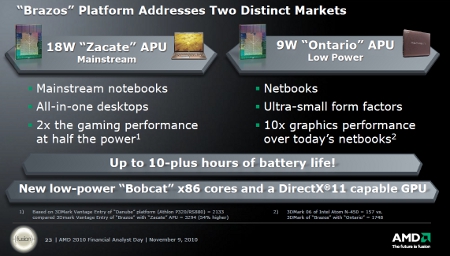AMD shows Fusion power: First public 32nm Llano demonstrations

AMD moved a step closer to its Fusion future with the first public demonstrations of its Llano processor, which combines a CPU and a graphics processor on a single chip manufactured using an advanced 32nm process. But the company gave no new details on exactly when Llano, which is designed for mainstream laptops and desktops, will ship in 2011.
At an event in Taiwan, AMD executives showed a Llano processor running three intensive applications-repeatedly calculating the value of Pi to 32 million decimal places on four threads, playing HD video from a Blu-ray disc, and running a physics simulation that uses DirectCompute, part of Microsoft's DirectX 11 that performs general-purpose computing on a GPU-all at the same time. In a video from the event, AMD's Chris Cloran said Llano would be capable of 400 to 500 gigaflops of performance (a gigaflop is a billion floating point operations per second). In a separate demonstration for the press (which I did not attend), AMD reportedly showed a Llano developer board smoothly running Aliens Versus Predator, a DirectX 11 game, at a resolution of 1024x768.
Llano isn't the first Fusion processor that AMD has demonstrated. It has previously shown off what it referred to as a "low-power" APU (Accelerated Processing Unit). That turned out to be a different chip, manufactured by TSMC on an existing 40nm process. There are two versions of this 40nm chip: Ontario, a low-power (9W) dual-core for netbooks and ultra-thin notebooks; and Zacate, an 18W dual-core processor for mainstream notebooks. Both have an on-die DirectX 11 GPU that should be comparable to the mid-range Radeon HD 5500 series. We've already seen some early performance numbers on these processors, which should begin shipping to computer makers this year and show up in retail early next year.
Llano is also designed for mainstream notebooks as well as desktops, but some me versions will have up to four CPU cores operating at higher frequencies and using more power. It will also be the first non-Intel CPU to use a 32nm manufacturing process and new transistor materials, namely a high-k dielectric, or insulator, and metal gates (HKMG). AMD and its manufacturing partner, GlobalFoundries, have had difficulty getting this complex process working efficiently, and Llano has been delayed. GlobalFoundries continues to say only that Llano is in "early production" but everything we've heard from AMD suggests that we won't see it until well into 2011.
Despite the delay, GlobalFoundries is likely to be the first contract chip manufacturer to produce a complex processor using HKMG-a significant technological achievement that the foundry emphasized in a statement released last night:
Our 32nm HKMG technology ramp is currently in early production at Fab 1 and we are making continued progress on ramping the process in support of AMD's 2011 customer commitments. We are the only foundry with experience in manufacturing high-performance integrated processors using HKMG technology. This experience will give customers at 28nm an industry-leading time-to-volume capability on this new technology.
There are rumors that rival TSMC, the world's largest foundry, would introduce its 28nm manufacturing process sometime during this quarter, but this is actually low-power process not suitable for high-performance CPUs and it uses conventional Silicon Oxynitride gates. TSMCs recipe for 28nm chips using HKMG won't appear until sometime next year.
TSMC had its own challenges with 40nm, but those are now behind it, which is why AMD has turned to the foundry for its first Fusion chips. Zacate appears to be a stopgap measure for AMD. It allows the company to get a high-volume Fusion processor for the mainstream market out the door while GlobalFoundries improves the manufacturing yields for Llano. It also allows AMD to release its first Fusion processors around the same time that Intel ships Sandy Bridge, which will also have a CPU and graphics processor on a single chip. The difference is that Sandy Bridge will use a 32nm manufacturing process and HKMG-both technologies that Intel already has a lot of experience manufacturing. It is unlikely that Sandy Bridge will offer the same level of graphics performance as AMD's Fusion (and Sandy Bridge does not support DirectX 11 yet), but Intel is improving graphics performance and early test results suggest it should be able to match an AMD's entry-level Radeon 5450 discrete graphics.
This looming battle between Intel's Sandy Bridge and AMD's Llano should result in some very powerful mainstream laptops at attractive prices through 2011.
